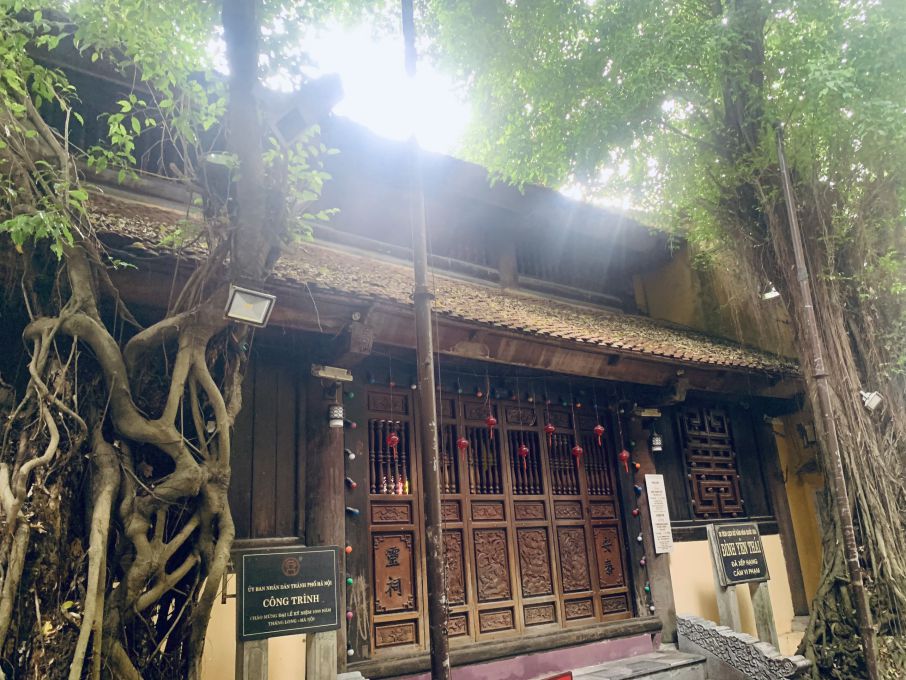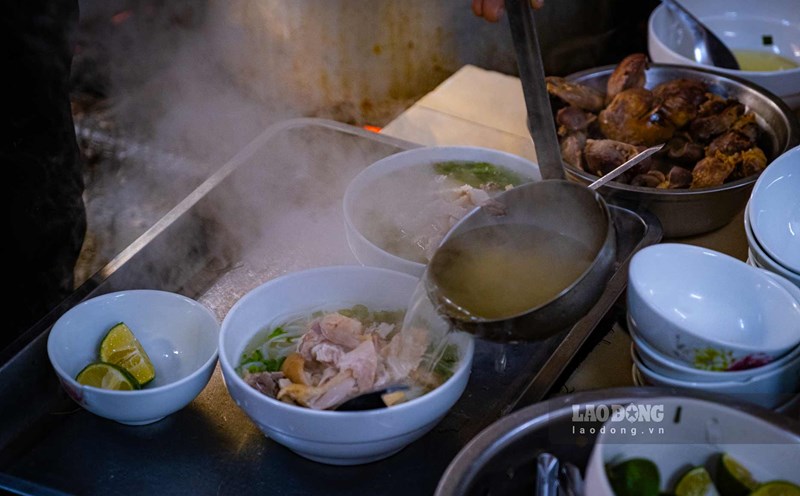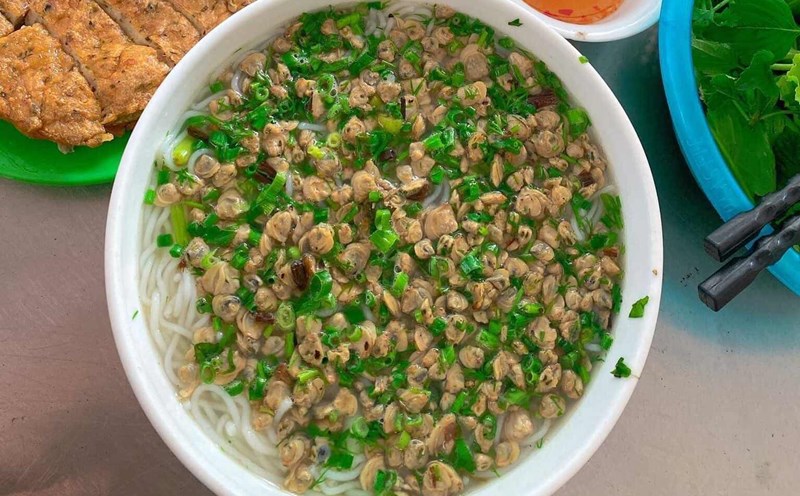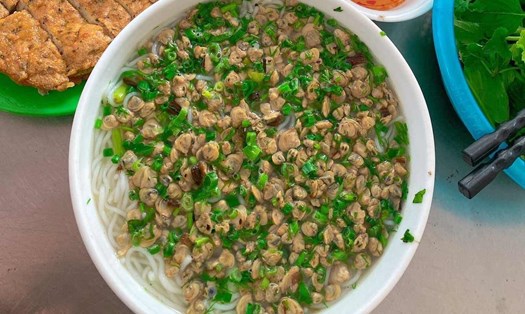The alley's designation "Love" has made people fall in love, even though it has nothing to do with people's broken hearts and six desires.
AN EXTREME ZICKZAC INJURY
Since I was a young man just entering Hanoi , I have loved the alley with a very impressive name: Temporary Alley. There are so many ways to explain this name, some romantic, some mundane, some rough, that we and I have heard, been told about, and read somewhere.
But in my geographical imagination, right from the beginning, I assumed that Temporary Thuong was related to the Phu Doan hospital area, including: Viet-German Hospital, Obstetrics Hospital C, Hospital Dental - Maxillofacial - Facial Hospital. That this is where patients stay temporarily before going to the hospital for treatment, just like the boarding houses for patients from far away that spring up around large hospitals.
Therefore, Thuong in the sense of Temporary Love means love (which in English is interpreted as hospitality). It is close to human emotions, between people and people, between Vietnamese people and each other. So just like that, it's natural to be attached and naturally compassionate.
But then, it turns out that's not the case. According to the book "Hanoi Street Dictionary" by author Giang Quan: "Old Temporary Alley belonged to Yen Thai village, Thuan My canton, former Tho Xuong district. "Around the beginning of the 19th century, this place was called Tram Thuong, a warehouse was placed to temporarily store tax rice paid by the people before transferring it to the main warehouse, called Temporary Warehouse, so it was later changed to Temporary Lane."
Oh, then the word "Love" refers to a profession, a profession is gone, it is commerce, trade, goods, and is no longer "love" at all. Just a temporary warehouse before rotation. But no matter what, this place is also a derivative alley and linked to the ancient geographical space of Yen Thai village, now Yen Thai alley or street, one end of which opens to Hang Da market, the other end of which opens to Hang Da market. Hang Manh street.
Temporary Lane is neither narrow nor wide. It is about 1,000 meters long, with two turns in the middle of the alley, one is short, and the other is a worker-shaped turn to connect with Yen Thai alley/street. If viewed from above, Temporal Lane will have a Z-shaped, zigzag shape, fragile but full of charm.
In the middle of the Z-shaped curved alley is the quiet Yen Thai communal house (literally called Quan Linh Tu), with two huge, towering banyan trees spreading cool canopy, like a touch that brings a bit of green. Fresh for the small alley. This makes Temporary Lane different from other alleys in the old town, as it has a banyan tree - a well (located behind the communal house) - a communal yard, just like a classic Vietnamese village roof.
The well is an eye for the earth to look up to the sky, and is also an eye for the blue sky to look into the deep earth. In Temporary Lane, there is not only one well behind the temple, but there were many wells, each house dug a well to get water for daily use.
I don't know what the source here is like or if there is spiritual energy gathering so there is an abundance of water. Just dig not very deep, more than ten meters and cool, fresh water will come pouring out. But then, when people multiplied, the land remained the same, the well became an "expensive" area while tap water was supplied to the house, one by one the wells were filled up, leaving only one or two for the household. communal house and ancient well behind the communal house.
Yen Thai communal house worships Nguyen Concubine Ỷ Lan - a loyal queen who was once regent and had the talent to govern the country and replace her husband in fighting distant enemies. She was the wife of King Ly Thanh Tong and mother of King Ly Nhan Tong. She was revered by the people as an outstanding woman, and later became a blessed goddess.
That's because Nguyen Concubine Ỷ Lan valued farming, loved the poor, strictly maintained the country's rules, and served as regent when King Ly Thanh Tong went to fight the Champa army, and was proclaimed "Ly Dai Mau Nghi" by the royal court. ", was honored by the devout Buddhist people as Buddha Mother "Tathagata appeared in the world, first in the Ly Dynasty of Thien Nam". At Quan Linh Tu, she is revered as the tutelary god of Yen Thai village.
According to documents kept in the communal house, Yen Thai communal house was built very early and to this day still retains the layout of a lovely small communal house, with a cong (I)-style architecture including a front house, a house Thien Huong and harem rooms, bearing the architectural appearance of the Nguyen Dynasty .
Yen Thai communal house has a rich history, which still preserves a large amount of relics, rich in type, diverse in materials, many in quantity such as stone stele, bronze bells, wooden and plastic palanquins. Yes, horizontal lines, couplets, great characters, stone objects and especially relics still preserve 10 precious colors.
Yen Thai communal house was ranked by the State as a National Historical and Cultural Relic in 1995. Thanks to the communal house and the sacredness of Mother Y Lan, on squirrel days, vigil days or Tet holidays, people in the alley and the surrounding area has a place to burn incense, consecrate, and pray for peaceful things. That is also the residence of spirituality in this alley.
RAINY AFTERNOON IN THE TAR OF THE OLD YEARS
In the past, just walking more than a dozen meters into Temporal Thuong alley, you will come across a very special pub, with a hint of the atmosphere of the famous sociable pubs in the Water Margin or the inherent wanderlust of Ancient Dragon. "An incident occurred in the tavern".
A small tavern located in the heart of an old house, with walls painted green and mottled with black smoke, or spider webs soaked in black dust, with only a few tiny drinking tables and stools. piles piled up all around. The entrance is very narrow, making the light in the tavern dim, increasing the mystery.
But the most mysterious are the old wine jars, covered with dust, their mouths covered with red towels that have lost their old color. These are jars of wine soaked in snakes of all kinds: Tam Xa (3 types of cobra, krait and snake), Five Snake (3 other types of snakes plus krait and tiger), and then dragon and tiger. Hoi (soaked with tiger bone extract) and wine soaked in traditional Chinese medicine.

This is the strangest snake wine shop I have ever sat in in my life because of its mysterious presence in the middle of urban bustle. The drink at that restaurant is also very strange: Sometimes it's stir-fried snake skin that sounds crispy but chewy and strangely chewy, sometimes the bowl of "rotten" peanuts tastes like goji berries but is unbelievably fragrant when eaten; When it's a plate of roasted pupusas with lime leaves or grilled eggplant. The menu is generally very arbitrary, what is sold according to the season or day.
In that half-light and half-dark space, sometimes blurred faces appeared attentively holding cups of wine or smelling of traditional medicine, or fishy with the smell of snakes priced at only 3,000 VND (a cup of jackfruit seeds) or 5,000 VND (a cup of roses). ), something like that. They all sipped and drank the wine that was said to be good for bones and health. At that time, I was only in my twenties, so I didn't know if it had any effect.
A strange point is that the pub did not have a name. Later, it was said that Mr. Tho's pub had existed for more than half a century. But I have never met Mr. Tho, I have only seen two women, mother and daughter, running the tavern, the daughter serving as the drink, the mother pouring the wine and paying for it.
There is a very impressive character who is deeply engraved in my mind at this tavern. He was a tall man with slightly curly hair and gray skin, a cross between black and yellow skin. He always wore French soldier-style clothes, made of khaki fabric, with large square pockets.
This guardian man always sits in a high chair near the door, only drinks wine, gulps down a cup of roses, then gets up to pay and leave. One day, he often stops by the restaurant to have a few drinks like that, drinks a lot, then goes away after drinking, not sitting next to the coffee, sipping.
I suspect that he is a mixed-race child of a certain African-American legionnaire and a Vietnamese woman here. In the past, there was a proverb in this area: Boys in Ngo Tram (next to Hang Da market, where a group of soldiers gather who rely on their authority to be arrogant), girls in Temporary Thuong (who are prostitutes who came here from somewhere to serve the case of French soldiers becoming venomous and promiscuous). It's just speculation, I don't know what the truth is.
Time passes quickly, Temporary Lane is now a place to enjoy snacks and entertainment from late afternoon to late at night. There is no more snake wine or strange guardian men, instead there are countless rows of fried spring rolls, fried spring rolls, and French fries. By simple count, there must be up to a dozen fried spring roll shops, stretching from the beginning of the alley to the intersection of Yen Thai communal house wall.
I still remember the fishy cup of snake wine on that rainy afternoon in 1997. It caught the yin and yang light that made the friend's words tilt towards poet Che Lan Vien's rambling poems about Temporal Alley:
The mist spreads on Temporary Thuong Alley.
The alley is very dead-end but the heart is far away.
The alley is seven meters but the heart is thousands of miles long.
A lifetime of love is not Temporary Love!








